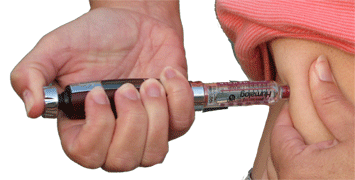Type 2 Diabetes

I’ve heard a lot about Type 2 diabetes in the news, but what is it?
Type 2 diabetes is when you become resistant to insulin. This can happen if the cells that make insulin in the pancreas can’t produce enough, or if you simply stop responding to it (lose your sensitivity).
Insulin is needed to take sugar in the blood and get it into the cells where it can be turned into useful energy.

Why does this happen?
You’ve probably read or heard that Type 2 diabetes is linked to obesity. That’s right.
You might also have heard it’s caused by obesity. That’s not quite right...
Obesity is a risk factor. There’s a theory Type 2 is caused by people eating a lot of carbohydrates in binges over a long period of time. If this happens, supposedly you cause a lot of insulin surges in the body. After years, these surges make you more used to higher levels of insulin in your system. In effect, you start to become resistant to that insulin.
You can also just become insulin resistant. It happens. And just as you’re more likely to get Type 1 when you’re young, you’re more likely to get Type 2 when you’re older.
Hang on, though Joe! What about the obesity link? Well, if you happen to become insulin resistant, you’re likely to feel tired a lot of the time, since not all the food you eat is getting turned into energy you can use in your cells. That's going to make you eat more, which will cause an insulin surge, making you even more resistant.
Who tends to get Type 2 diabetes?

Well, everyone it seems! You don't have to be obese, but it is a risk factor as is age: people over 40 are more likely to get Type 2 Diabetes. Some ethnic groups (e.g. South Asian) seem to be more at risk of developing it than others too. In the UK, Type 2 is becoming more common in children and young people, no matter their ethnic background.
Around 90% of diabetics are Type 2, which means that in 2015 it affected about 3 million people in the UK. The numbers are even higher in some places around the world, and they are growing every year.

Wait, is this ‘good’ or ‘bad’ diabetes?

Um, neither… Do you mean, is it the one where you have to inject? Then the answer is yes and no!
In short though, Type 2 Diabetes is just as serious a condition as Type 1 Diabetes. It can be treated in lots of different ways (please see Diabetes UK for information on specific medications), but can include gentle exercise and weight loss, as well as possibly other treatments.
About 50% of Type 2 diabetics go on to take insulin injections as the disease progresses. It is not necessarily a sign of bad control, but can be due to weight gain, long-term emotional or physical stress, or simply getting older.

If you are Type 2 and using insulin, Joe’s Rough Guide to Diabetes can help you learn how to control your blood sugar levels. If you are using a long- and a short-acting insulin, you might also find the Small-in-one a handy piece of kit.
But just because you may be in the 50% that don’t need to inject, it doesn’t mean you should take it lightly. Diabetes is the leading cause of blindness, kidney disease and amputation in the UK. And remember 90% of diabetics are Type 2.
In fact, arguably Type 2 is more dangerous than Type 1 diabetes. Its symptoms develop slowly and most people put getting tired, fatter, or their eyesight worsening down to ‘just getting older’. So by the time you know you’ve got it, you’ve probably had it uncontrolled for a while. Type 1 diabetes comes on quickly and its symptoms are noticeable (see Diabetes Signs & Symptoms and/or Diabetes Diagnosis & Stigma for more detail). On top of that, people tend to get Type 2 in middle age, when they’re set in their ways and find it more difficult to change.
If you are Type 2 but are not using insulin and are interested in improving your control please check out Type 2 Diabetes Education and The Diabetes Manual Complete.
